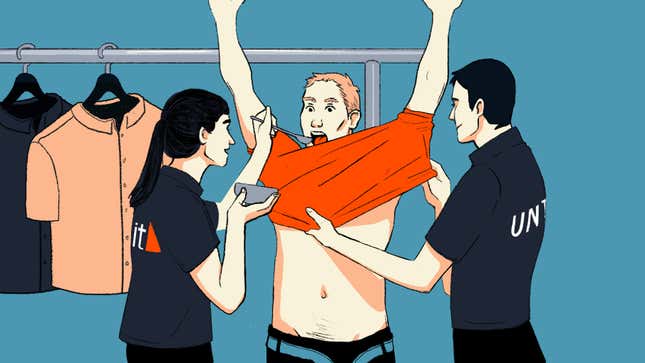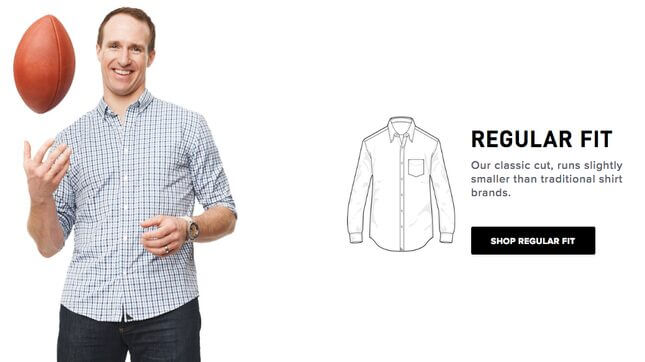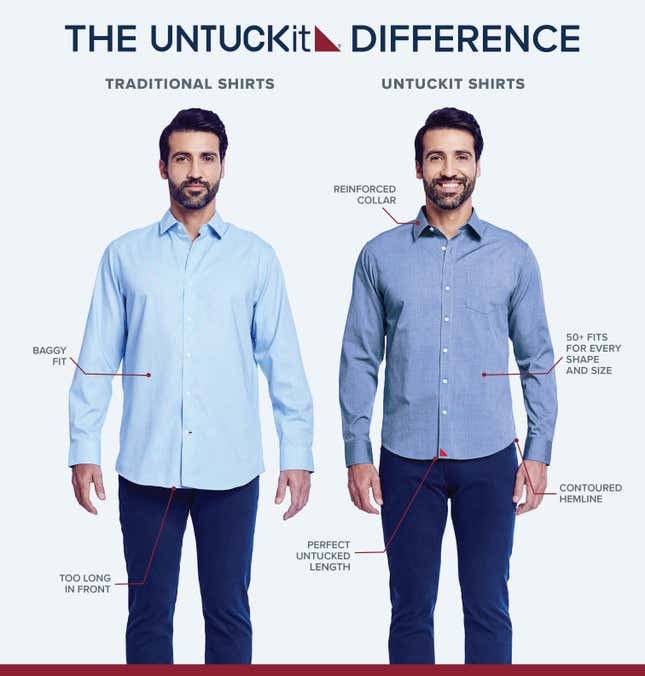
Image: Angelica Alzona/GMG
“Men just want to find a fit and then not change from that,” Chris Riccobono, founder of the menswear brand Untuckit (or, as the brand styles it, UNTUCKit), says. “They don’t really want to have to overthink their outfit.”
Riccobono has also found that men don’t like to iron their clothes. That men now typically own, say, 10 casual shirts and one dress shirt, though they’d rather wear the casual ones to everything from ball games to nice dinners. Most importantly, they need shorter shirts; or, at least, they haven’t yet realized they need shorter shirts. The entire Untuckit brand is built on the apparently groundbreaking idea that a typical men’s button-up should be shorter.
Regular men’s shirts, in Riccobono’s eyes, are too long. They’re designed to be tucked in and thus arguably designed for a man of an increasingly bygone era, when men were expected to tuck in their shirts to meet a Don Draperian standard of formality. This shirt-length problem first became a nagging concern to Riccobono when he went on a trip to Las Vegas with his buddies. He had three shirts with him, one of which was a size small but it fell to “the perfect length.” “Every time the next night came, I would go put on a new shirt but it looked so long,” he says. “So I put the shirt back on for three nights in a row.”
“I asked all my friends who were there, do you have the same problem?” Riccobono says, a Jersey accent underlining every word, casual in a grey henley and baseball cap. We are sitting in Untuckit’s modest SoHo office, where the white, glass-walled conference rooms bear the names of different wineries (Larkmead, Spottswoods) to reflect Riccobono’s noted affinity for wine. “Instead of being like you’re crazy, they all had the exact same problem,” he says.
It was also a problem Riccobono, who was working in medical sales at GE Healthcare at the time and attending Columbia business school, felt he could solve and monetize. Riccobono and his co-founder Aaron Sanandres did a survey of 500 men in Hoboken, New Jersey, where Riccobono was living at the time, and found that other men had this elusive problem as well (Untuckit declined to provide this survey data, explaining they don’t share it formally).
“My thought as an entrepreneur was if I legitimately had a problem then I can’t be the only guy with the problem,” he says. “And this was legitimately a problem. I did not have a shirt other than this one shirt that I could wear that was not too long.”

That problem is now a multi-million dollar company, with 50 stores across the country. In 2018 the company, founded in 2011, reportedly had $150 million in sales and was seeking a valuation of $600 million, which Riccobono says will help them go overseas. A representative for Untuckit declined to provide revenue numbers but shared that the company has a four-year compounded annual growth rate of 150 percent. The menswear industry has noticed: recently J. Crew and The Gap have started selling shirts designed to wear “untucked.”
Untuckit’s success and creeping ubiquity are still surprising. Starting a company with the crusade that men need shorter shirts (and are apparently incapable of finding them) seemed like a joke. “It was impossible early on when I went to friends and family,” Riccobono says about first seeking investors. “They’d say, you’re making a shorter shirt?” Even the brand’s name, which bears the simplicity of the brand’s mission, trips off the tongue like a work in progress. Though they’ve expanded into other clothing items, the famous shirt at the center of Untuckit’s rise still begs the question: Does this really need to exist?
Talking to Riccobono, it’s clear that what Untuckit is ultimately selling to men isn’t really a shorter shirt at all; they’re selling help. Untuckit provides a substitute for the sort of traditionally feminine labor a lot of men need when shopping. They are a new set of eyes to evaluate how sloppy customers look or a helping hand to get them dressed. Untuckit is a discerning wife or a mommy.
At the Untuckit SoHo store, there is a large-scale diagram, notably situated above a bar cart featuring a small variety of bourbon and scotch (yes, for the taking), that advertises “The UNTUCKit Difference.” It features a photo of a man in a “traditional shirt” versus an “UNTUCKit shirt.” One is “baggy” and too long, the other is slimmer, tighter, and falls at a higher length. The differences are slight.
There’s something clinical about the poster and its overly educational presence, but that’s the point. Men “don’t know the way they look,” Riccobono tells me as I make my way through the small store while Fleetwood Mac plays softly through the speakers. An almost-mural sized photo of different men showcasing Untuckit’s size range (which includes big and tall sizes) spans a wall. I’m told it’s a particularly helpful visual aid for customers who want to figure out their own size or those of people they’re buying for.
The Untuckit store is hyper-designed to accommodate men that don’t really want to be there. If the merchandise selection seems slim in the store, that’s a purposeful decision. “Most guys don’t want to try on a bunch of clothes or styles at once,” a sales associate says. Untuckit streamlines the process for them. When men come into the store, the first thing they do is find their fit by selecting from a plain set of shirts in a range of sizes back at the dressing room (mirrors are also placed outside to encourage consultation). Once they have their fit, they can pick from the prints and fabrics available. There are no registers, rather customers check out on the spot. “Guys don’t want to get into a line,” the associate adds.

Riccobono talks about the classic Untuckit shirt in dramatically scientific terms. It took 10 technical specialists, who Riccobono had consult from places like Bonobos and J. Crew, until they found the perfect fit. Almost all of them said they “couldn’t make a shirt this short,” he says. “Every time you shorten the length the body changes, that’s why you can’t just go get a shirt shortened.” He continues, “we had to create a size in every shirt and make sure that it could fit all of these men; when you’re big the shirt pulls up on you… when you’re thin the shirt drops down.” Untuckit’s “regular fit” shirts “run on the smaller side of average.”
The sort of technically overcomplicated simplicity of a brand like Untuckit, which started out as e-commerce only, feels familiar in the world of startups. This is what industry “disruption” is built on; Harry’s disrupted the shaving market, Warby Parker disrupted the eyeglass industry, Uber disrupted taxi services, Airbnb disrupted hotels, and so on. The hunger some entrepreneurs have for unnecessary disruption can lead to widely mocked results, from complicated juicing machines that can be replicated by hand to Rogaine rebrands.
When I ask Riccobono if he thinks Untuckit is a disrupter of menswear he says yes, “massive.” They are concept first, fashion second, no designer bells and whistles. “For us it’s, have you ever had a problem wearing a shirt untucked?” he says; there’s not a name like John Varvatos or Ralph Lauren attached, though they do use football players like Drew Brees in their ads and tout celebrity fans like former Bachelor Colton Underwood. But the problem is bigger than just needing a shirt to wear untucked, it’s also a problem of not knowing how to easily dress oneself. “I just think we created this excitement that men want to shop. Men want to buy our shirts personally. They don’t need their wives to buy them.”
I thought about wives who shop for their husbands when browsing Untuckit merch, but also mothers who call out to their sons to tuck in their shirts—women who do the laundry, press shirts or take them to the dry cleaner. Untuckit has no qualms that part of its duty as a brand is to explain to men that their shirts are better, but the messaging is also sort of infantilizing. It’s not just that the product is physically better, it’s that it eliminates work; the work of tucking in a shirt in the first place, the work of tidying oneself up.
But a lot of corner-cutting industry disruption, largely at the hands of male entrepreneurs, is inherently infantilizing. In a piece for Boston Review last year titled “Going to Work In Mommy’s Basement,” Sarah Sharma wrote about the idea of the devalued, feminized labor associated with “mommies,” and how it has pervaded Silicon Valley. “The term ‘post-mom economy’ emerged to capture this particular moment in tech(bro) culture when Uber (‘Mommy, drive me’), TaskRabbit (‘Mommy, clean my room’), GrubHub (‘Mommy, I’m hungry’), and LiveBetter (‘Mommy, I’m bored’) emerged,” she wrote. “These services do not replicate, reproduce, or replace Mommy. Instead, they extend the maternal mandate to all other care providers and expand the realm of consumption.”
Untuckit isn’t a service, nor is it a Silicon Valley titan, but it’s hard not to hear cries of “Mommy, dress me” radiating from its linen button-ups. The brand has built a shopping ecosystem for men that cushions every interaction in case they get too frustrated with the process. Riccobono stresses that because his customer base is so massive, from young 20-somethings to older men, he has no specific profile for the sought-after Untuckit customer. But given the execution of the brand, Untuckit believes they are uniformly lazy, a gruff stereotype of a man who not only can’t bother with fashion, he can’t bother finding the right shirt. Though Untuckit has moved to womenswear in recent years, Riccobono admits that it’s an imperfect process, having modeled their first women’s clothes off of the men’s designs. “Women’s is really hard because they really pay attention to changes in style and fit,” he says. The brand has since moved to more “feminine” designs which have proven more successful, but it stands that women clearly didn’t need the same built-in help that made menswear thrive.
It isn’t just Untuckit that approaches its customer this way. Many menswear brands in the start-up sphere approach their target customer like a large child; he is fussy, impatient, and must wear clothing that can withstand the dirt and grime he plays in. “Like most guys, we’re not big fans of shopping,” says Bonobos, which makes chinos that are “water, stain, and dirt repellent.” The menswear subscription styling service Bombshell once carried the tagline “girlfriend-approved clothes for the lazy man.” “It only takes three minutes. Then you’ll never have to visit a clothes shop again,” subscription box Thread promises.
“You see these before and after pictures of guys who were not wearing Untuckit and when they put [it on] they look younger, they look more vibrant, it’s amazing,” Riccobono says. “Most men have never really thought about it until we drew attention to the problem.”
Like a good mother laying out her son’s clothes to wear, Untuckit is ever the problem-solver.